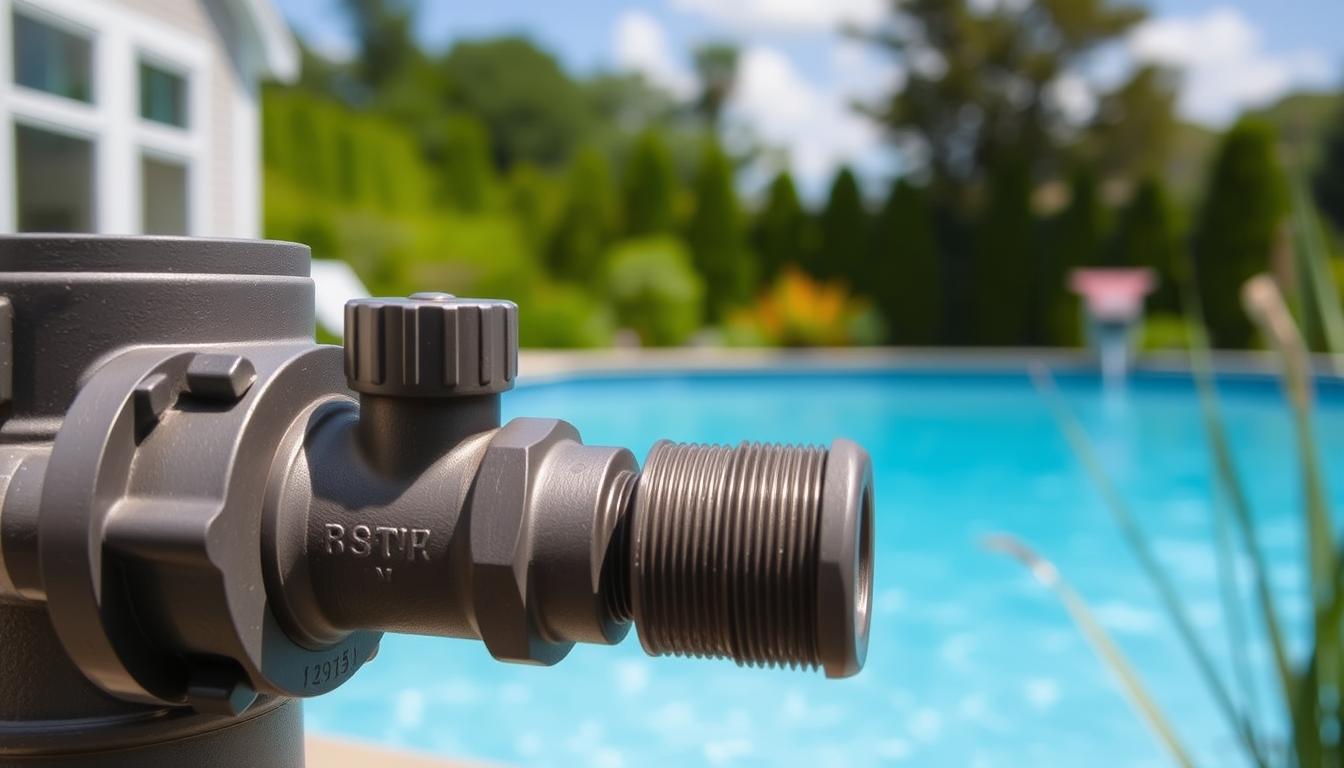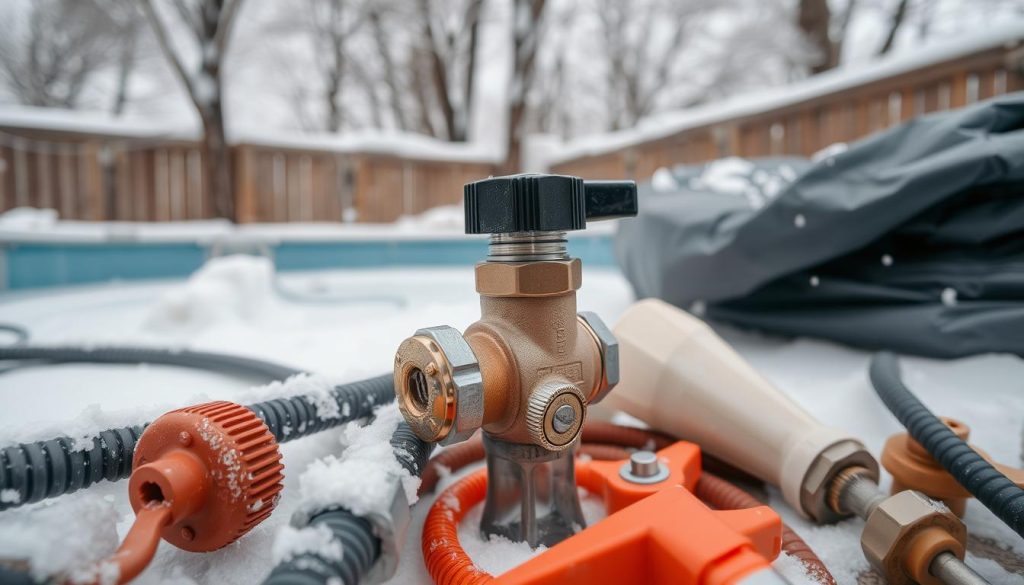
Summer’s end signals pool winterizing time. A whopping 80% of pools need specific winterizing care. Proper pool closing prevents costly repairs, with 95% of owners recognizing its importance.
The shut off valve is crucial for winterizing above ground pools. It controls water flow and allows for maintenance. Understanding this component ensures your pool stays in top shape year-round.
This guide covers above ground pool shut off valves in detail. We’ll explore types, selection factors, and installation steps. You’ll gain confidence in winterizing your pool and protecting your investment.
Surprising facts: 70% of pool owners report cracked Gizzmos. Also, 85% of experts recommend backwashing DE filters in spring, not during closing.
Let’s explore pool valve shutoffs and their role in winterizing. By mastering this skill, you’ll ensure a worry-free winter and a sparkling summer pool.
Understanding Pool Valve Positions
Mastering pool valve positions is vital for above ground pool maintenance. These settings control water flow and pump force. Proper use optimizes cleaning and ensures good water circulation.
Most above ground pools have a diverter valve. It links pool skimmers and the main drain. This pool pipe valve manages suction from different pool areas.
Fully Open Position
The fully open position is the default for most pool valves. All ports work, allowing maximum water pressure and circulation. Water comes from both skimmers and main drain.
Skimmer Ports Closed
Closing skimmer ports with the skimmer valve pool makes the main drain the only suction source. This setting targets debris at the pool bottom. It effectively removes dirt from the pool floor.
Main Drain Port Closed
Closing the main drain port directs all suction to the skimmers. This setting cleans the water’s surface. Skimmers capture floating debris like leaves and insects.
Pool Pump Port Closed
Close the pool pump shutoff valve only when the equipment is off for maintenance. This prevents water from entering the pump during servicing. Remember to reopen before turning the pump on.
Partial Closure of Ports
Partially closing pool filter valve ports helps find optimal cleaning settings. This fine-tunes suction power. It ensures effective cleaning of both water surface and pool floor.
| Valve Position | Function |
|---|---|
| Fully Open | All ports functioning for maximum water pressure and circulation |
| Skimmer Ports Closed | Main drain as the only source of suction, targeting bottom debris |
| Main Drain Port Closed | All suction directed to skimmers, focusing on surface cleaning |
| Pool Pump Port Closed | Used during equipment maintenance or repairs, prevents water from entering pump |
| Partial Closure of Ports | Fine-tuning suction power for optimal cleaning of water surface and pool floor |
By mastering the different pool valve positions, you can ensure efficient water circulation and effective cleaning of your above ground pool. Experiment with various settings to find the perfect balance for your pool’s unique needs.
Winterizing Your Above Ground Pool Shut Off Valve
Fall is here, and it’s time to winterize your above ground pool. Proper winterization keeps your pool in great shape during cold months. Your pool shut off valve is key in this process.
By following these steps, you’ll protect your pool from freezing damage. You’ll also ensure a smooth opening when spring arrives.
When to Start Winterizing
Start winterizing when temperatures drop below 65°F (18°C). This usually happens in late fall, depending on where you live. Timing is crucial to prevent algae growth and equipment damage.
Cleaning and Balancing Water Chemistry
Clean your pool thoroughly before closing it for winter. Balance the water chemistry for clear water all winter. Aim for pH levels of 7.2 to 7.8 and alkalinity of 80 to 120 ppm.
Keep chlorine levels between 1 to 3 ppm. Add winterizing chemicals to protect against scum, scale, stains, and algae growth.

Lowering Water Level
Lower the water level based on your pool cover type. For solid covers, reduce water 3-4 inches below the skimmer. This allows for rain or snow displacement.
With mesh covers, lower water 12-18 inches below the skimmer. This prevents water from touching the cover. Use foam rope or specialized products to protect the skimmer.
Winterizing Pool Pump and Plumbing System
Start by disconnecting the pump, filter, heater, and other equipment. Drain water from these parts. Use a blower to remove leftover water from pipes.
Seal return lines and skimmer openings with winterizing plugs. Add pool-safe antifreeze if you can’t fully drain the lines.
| Winterization Step | Key Points |
|---|---|
| Timing | Begin when temperature consistently drops below 65°F (18°C) |
| Water Chemistry | pH: 7.2-7.8, Alkalinity: 80-120 ppm, Chlorine: 1-3 ppm |
| Water Level | Lower 3-4 inches (solid cover) or 12-18 inches (mesh cover) below skimmer |
| Pump and Plumbing | Disconnect, drain, and blow out lines; use winterizing plugs and antifreeze |
Follow these steps to winterize your above ground pool shut off valve and related parts. Your pool will stay in top shape all winter. This makes spring opening a breeze.
Choosing the Right Above Ground Pool Shut Off Valve
Selecting the best above ground pool shut off valve requires careful consideration. Look for a durable valve made from high-quality materials like CPVC or PVC. These materials can withstand harsh pool conditions and frequent use.
Choose a valve size that matches your pool’s pipe dimensions for a proper fit. Brands like Jandy, Pentair, and Hayward offer compatible valves for various plumbing systems. These options provide easy maintenance and reliable performance.
For expert advice, consult a pool professional or check reviews from trusted sources like Pool Clinics. They can offer insights tailored to your specific pool setup. Investing in a high-quality valve ensures a more efficient and trouble-free pool experience.







